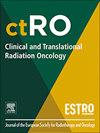Detection of alteration in carotid artery volumetry using standard-of-care computed tomography surveillance scans following unilateral radiation therapy for early-stage tonsillar squamous cell carcinoma survivors: a cross-sectional internally-matched carotid isodose analysis
IF 2.7
3区 医学
Q3 ONCOLOGY
引用次数: 0
Abstract
Aim
This study leveraged standard-of-care CT scans of patients receiving unilateral radiotherapy (RT) for early tonsillar cancer to detect volumetric changes in the carotid arteries, and determine whether there is a dose–response relationship.
Methods
Disease-free cancer survivors (>3 months since therapy and age > 18 years) treated with intensity modulated RT for early (T1-2, N0-2b) tonsillar cancer with pre- and post-therapy contrast-enhanced CT scans available were included. Patients treated with definitive surgery, bilateral RT, or additional RT before the post-RT CT scan were excluded. Isodose lines from treatment plans were projected onto both scans, facilitating the delineation of carotid artery subvolumes in 5 Gy increments (i.e. received 50–55 Gy, 55–60 Gy, etc.). The percent-change in sub-volumes across each dose range was examined.
Results
Among 46 patients, 72 % received RT alone, 24 % induction chemotherapy followed by RT, and 4 % concurrent chemoradiation. The median interval from RT completion to the latest, post-RT CT scan was 43 months (IQR 32–57). A decrease in the volume of the irradiated carotid artery was observed in 78 % of patients, while there was a statistically significant difference in mean %-change (±SD) between the total irradiated and spared carotid volumes (−7.0 ± 9.0 vs. + 3.5 ± 7.2, respectively, p < 0.0001). Chemotherapy use, in addition to RT, was associated with a significant mean %-decrease in carotid artery volume compared to RT alone. No significant dose–response trend was observed in the carotid artery volume change within 5 Gy ranges.
Conclusions
Our data show that standard-of-care oncologic surveillance CT scans can effectively detect reductions in carotid volume following RT for oropharyngeal cancer. Changes were equivalent between studied dose ranges, denoting no further dose–response effect beyond 50 Gy.
早期扁桃体鳞状细胞癌幸存者单侧放射治疗后使用标准护理计算机断层扫描监测检测颈动脉容量改变:横断面内匹配颈动脉等剂量分析
目的:本研究利用标准护理CT扫描的患者接受单侧放疗(RT)早期扁桃体癌检测颈动脉体积的变化,并确定是否存在剂量-反应关系。方法:纳入接受强度调节RT治疗早期(T1-2, N0-2b)扁桃体癌的无病癌症幸存者(治疗后3个月,年龄> - 18岁),治疗前和治疗后可用对比增强CT扫描。排除了接受明确手术、双侧RT或在RT后CT扫描前进行额外RT的患者。治疗方案的等剂量线投射到两个扫描上,有助于以5gy增量描绘颈动脉亚体积(即接受50-55 Gy, 55-60 Gy等)。检查了每个剂量范围内亚体积变化的百分比。结果:在46例患者中,72%的患者单独接受了放疗,24%的患者接受了诱导化疗后再进行放疗,4%的患者同时接受了放化疗。从RT完成到最近一次RT后CT扫描的中位时间间隔为43个月(IQR 32-57)。78%的患者观察到放疗后颈动脉体积减小,而总放疗和保留颈动脉体积之间的平均百分比变化(±SD)差异有统计学意义(分别为-7.0±9.0 vs + 3.5±7.2)。结论:我们的数据显示,标准护理肿瘤监测CT扫描可以有效地检测口咽癌放疗后颈动脉体积的减小。所研究的剂量范围之间的变化是相等的,表明超过50 Gy后没有进一步的剂量反应效应。
本文章由计算机程序翻译,如有差异,请以英文原文为准。
求助全文
约1分钟内获得全文
求助全文
来源期刊

Clinical and Translational Radiation Oncology
Medicine-Radiology, Nuclear Medicine and Imaging
CiteScore
5.30
自引率
3.20%
发文量
114
审稿时长
40 days
 求助内容:
求助内容: 应助结果提醒方式:
应助结果提醒方式:


